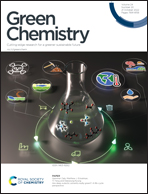Study of green bio-oil-glyoxal novolac resins synthesis and its curing with bisphenol A diglycidyl ether and biochar
Abstract
The synthesis of a greener novolac-type resin using glyoxal, upgraded bio-oil, and oxalic acid, has been studied. Glyoxal replaces formaldehyde which is a toxic reagent that is, currently used for the synthesis of bio-oil glyoxal (BOG) resin. The pyrolysis bio-oil was pre-upgraded by fractional condensation followed by a water extraction method. Mimic phenol glyoxal resin and phenol glyoxal resin (MPG and PG) were also synthesized to determine the benefit of the BOG resin. On the other hand, bisphenol A diglycidyl ether (DGEBA) was used as a formaldehyde-free cross-linker for bio-oil-based glyoxal resins, and the pyrolysis biochar was examined for the first time as a curing additive. The physicochemical and thermal properties of PG, MPG, and BOG resins before and after curing were compared. The kinetic parameters of the reaction were determined by model-free methods using data obtained from the differential scanning calorimeter (DSC). The BOG resin showed a similar curing activation energy as that of the PG resin (89.5 and 86.4 kJ mol−1). Moreover, the addition of biochar can effectively decrease the onset temperature and the activation energy of the curing process. The results have demonstrated the potential of treated bio-oil products to effectively replace commercial phenol.



 Please wait while we load your content...
Please wait while we load your content...